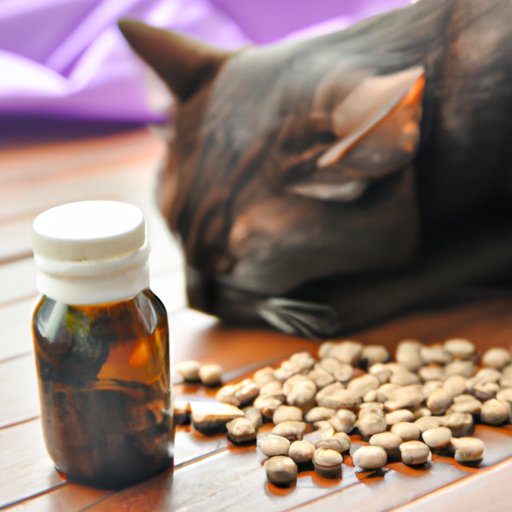Introduction
Benadryl has long been used as a remedy for allergies in humans, but did you know that it can also be used to help cats with allergies? While there are many medications specifically designed for cats, Benadryl is often seen as a safe and effective option. But just how much Benadryl can you give a cat? In this article, we’ll explore the benefits and risks of giving Benadryl to cats, as well as provide recommended dosage guidelines and alternatives if your cat cannot take Benadryl.
An Overview of How Much Benadryl is Safe for Cats
The amount of Benadryl you can give to your cat depends on several factors, including its age, weight, and the severity of its allergy symptoms. Generally speaking, the recommended dose of Benadryl for cats is 1mg/pound of body weight, given twice daily.
It’s important to note that Benadryl can have both beneficial and adverse effects for cats. On the one hand, it can help relieve symptoms of allergies like sneezing, itching, and watery eyes. On the other hand, too much Benadryl can lead to serious side effects, including vomiting, diarrhea, and even heart problems. Before giving your cat Benadryl, it’s important to consult with your veterinarian to ensure that it is the right choice for your pet.
What to Consider Before Giving Your Cat Benadryl
Before administering Benadryl to your cat, there are a few things you should consider. First, it’s important to determine whether or not your cat has any underlying health issues that could be affected by the medication. Certain conditions, such as kidney or liver disease, may increase the risk of side effects from Benadryl. Additionally, cats that are pregnant or nursing should not be given Benadryl.
It’s also important to be aware of the potential side effects of Benadryl. Common side effects include drowsiness, loss of appetite, and dry mouth. If your cat experiences any of these symptoms, stop administering the medication and contact your veterinarian immediately.
Finally, it’s important to consider the age and health of your cat. Benadryl is not recommended for kittens under 6 weeks old, as their bodies may not be able to handle the medication. Additionally, older cats or those with existing health problems may be more susceptible to the side effects of Benadryl.
How Benadryl Can Help Cats with Allergies
Benadryl is an antihistamine, which means it works to reduce the body’s response to allergens. By blocking the release of histamines, Benadryl helps to reduce inflammation and swelling associated with allergic reactions, as well as providing relief from common allergy symptoms like sneezing and itching.
In addition to relieving allergy symptoms, Benadryl can also help to prevent future allergic reactions. By reducing the body’s response to allergens, Benadryl can help to reduce the severity of future reactions and alleviate symptoms more quickly.

Side Effects of Giving a Cat Too Much Benadryl
It’s important to be aware of the possible side effects of giving your cat too much Benadryl. Overdoses of Benadryl can lead to serious complications, including difficulty breathing, rapid heartbeat, seizures, and coma. If you suspect your cat has overdosed on Benadryl, contact your veterinarian immediately.
Additionally, long-term use of Benadryl can cause serious health problems, including liver and kidney damage. For this reason, it’s important to only give your cat Benadryl when absolutely necessary, and to follow your veterinarian’s recommended dosage guidelines.

Dosage Guidelines for Administering Benadryl to Cats
When administering Benadryl to your cat, it’s important to follow the recommended dosage guidelines. The general rule of thumb is 1mg/pound of body weight, given twice daily. However, this may vary depending on the age and health of your cat.
For kittens under 6 weeks of age, it is not recommended to give Benadryl at all. For cats between 6 weeks and 6 months old, the recommended dose is 0.5mg/pound of body weight, given twice daily. For cats over 6 months of age, the recommended dose is 1mg/pound of body weight, given twice daily.
It’s important to note that these are general guidelines, and your veterinarian may recommend a different dosage depending on your cat’s individual needs. Additionally, Benadryl is available in both liquid and tablet form, so be sure to check the label for instructions on proper dosage.

Alternatives to Benadryl for Cats Who Cannot Take It
For cats who cannot take Benadryl due to age or health concerns, there are a few alternatives. Natural remedies such as chamomile tea and oatmeal baths can help to soothe itchy skin and reduce inflammation. Additionally, there are a number of prescription medications available for cats with allergies, so be sure to speak to your veterinarian about what options are best for your pet.
Conclusion
Benadryl can be a safe and effective option for cats with allergies, but it’s important to be aware of the potential risks and side effects. Be sure to consult with your veterinarian before giving your cat Benadryl, and always follow the recommended dosage guidelines. If your cat cannot take Benadryl, there are a number of natural remedies and prescription medications available. For more information on Benadryl for cats, be sure to speak to your veterinarian.
(Note: Is this article not meeting your expectations? Do you have knowledge or insights to share? Unlock new opportunities and expand your reach by joining our authors team. Click Registration to join us and share your expertise with our readers.)
